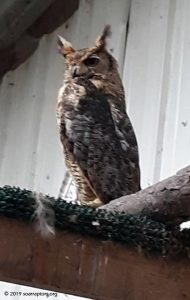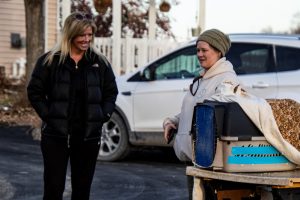“Henry’s Success Story”
December 9th, 2019 by Ric Hanson
(Submitted By Lora Kanning Cass County Conservation) — August 16, 2008 was my (Lora Kanning’s) first Breakfast with the Birds as our Cass County Naturalist. I remember being excited to have Kay Neuman confirmed for the program with a Great Horned Owl to release in Sunnyside Park. I also remember being disappointed by only 13 people coming out that year to the program. Fast forward 11 years, To August 2019, I was contacted by a homeowner Brenda Nelson who lived south of Atlantic, about a Great Horned Owl who she’s named “Henry” always lived near her property for the past 4 years. At the time, Henry was just oddly hanging out closer to her house instead of the woods, we chatted about how he was acting, all seemed fine. Until 8 days later she contacted me again with a video of him, super close to her house, on the ground, and frankly looked a little roughed up! I loaded up my Conservation vehicle and headed out that morning. After a little bit of poop, and a little chase, I rescued “Henry” and he was safely inside a carrier. I then called Kay Neuman with SOAR- (Saving Our Avian Resources) out of Dedham. I have learned my lesson don’t call Kay until the bird is in the carrier, there has been many a rescue where it takes more people or time to rescue the injured wildlife. When I was catching him, and putting him in the carrier, besides the skunk smell, he had some “extra jewelry” a bird band! Kay was available to meet up and safely transfer him to SOAR’s care. This is an example of a bird band encounter. If you find a banded bird you should report the band number and location to reportband.gov. The band encounter was reported and this great horned owl was banded by Kay before being released on the southwest edge of Atlantic, Iowa… 11 years ago! This is dispersal information, dispersal from release location for this owl, was Sunnyside park to where he was found was about 10 miles. This is important for a raptor rehabilitator to know – great horned owls may not travel or disperse very far from where released. The great horned owl pictured here is that banded owl in a flight pen regaining flight skills.
Why band birds?
The data collected from the bird bander and from people that have an “encounter” with an already banded bird provide useful information for scientific research and management activities. Bird banding data helps biologists understand dispersal, migration, longevity, behavior, productivity, and more.
This great horned owl’s band encounter adds to the collection of reports for longevity. Curious about how long has a certain species has lived? Visit the BBL longevity search page: https://www.pwrc.usgs.gov/bbl/longevity/Longevity_main.cfm Great Horned Owls like “Henry” can live up to 30 yrs old in the wild. He is estimated to be approximately 12 years old.
Differences between banding birds and using telemetry?
Both bands and telemetry must be put on the bird by someone with the banding permit. Data collected from band encounters is not (hopefully) quickly known by the bander. With raptors, band encounters may happen through research projects including hawk banding stations, through birds being admitted to a rehabilitator, or by birds being found dead in the field.
A telemetry unit permit is most often associated with a large-scale research project that has substantial funding and partner agencies. Tracking a bird with telemetry varies depending on the type of unit — a UHF unit that can be monitored using a handheld antennae, a telemetry unit that utilizes satellite technology, or a GPS-GSM telemetry system where data points are downloaded when the unit has cellular signal.
But back to “Henry”… Cass County Conservation was given updates on Henry every couple weeks to know his progress. Most likely “Henry” lost a fight with a skunk, Great Horned Owls are the #1 predator of Skunks in Iowa. Recovery from the spray probably directly to the eyes and a head injury. November came around, it started to look like he was getting very close to coming “home” to Cass County. We discussed dates, of course, mother nature with her high wind events pushed off his release a little bit. December 5th 2019 was a great day to come home, of course with the help of SOAR, Cass County Conservation Board and the homeowner Brenda, “Henry” was released right back where we found him.  We would also like to thank Sandy McCurdy for volunteering to take the photos of the release. “Henry” of course was ready to go, he came right out of the carrier. He flew into the forest and sat in a tree for us for awhile. Checking out that he was back somewhere familiar! You can also checkout his release video on Cass County Conservation’s Facebook Page.
We would also like to thank Sandy McCurdy for volunteering to take the photos of the release. “Henry” of course was ready to go, he came right out of the carrier. He flew into the forest and sat in a tree for us for awhile. Checking out that he was back somewhere familiar! You can also checkout his release video on Cass County Conservation’s Facebook Page.
Many times wildlife rescue does not end with a happy story. Which is one of the reasons why we wanted to share “Henry’s” story with the residents of Cass County. Another reason is to raise awareness on how lucky we are in Cass County to have wildlife rehabbers regionally close to us like SOAR. SOAR runs on donations as a 501(c)(3) organization established in 1999 dedicated to saving our avian resources through raptor rehabilitation, education, and research. Your year-end donation will help us, stock freezers with the high quality food needed for our patients and ambassadors, buy blood lead testing supplies, and medications. Coming up on year end donations consider donating to SOAR, www.soarraptors.org.






